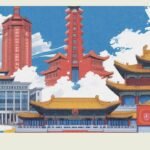Everyday Life in China: Homes, Food, Transportation and More
Gain fascinating insights into how over 1 billion people live their daily lives in China.

China is a vast country with a land area spanning over 9.6 million square kilometers and a population of nearly 1.4 billion people. This immense size and population contribute to the diverse lifestyles and experiences found throughout the nation. From the bustling megacities to the remote rural villages, from the arid deserts to the lush tropical regions, China’s geography is as varied as its people.
Life in China can differ greatly depending on factors such as region, urban versus rural settings, income levels, and ethnic backgrounds. The country is home to 56 officially recognized ethnic groups, each with their own unique traditions, languages, and customs. While the Han Chinese make up the majority, the minority groups add to the rich cultural tapestry of the nation.
In urban centers like Shanghai, Beijing, and Guangzhou, life is fast-paced and modern, with a focus on career advancement, consumerism, and technology. These cities are hubs of economic activity and attract people from all over China seeking better job opportunities and a cosmopolitan lifestyle. However, in rural areas, agriculture remains a primary occupation, and life is often slower-paced, with a stronger emphasis on traditional values and community ties.
Income levels also play a significant role in shaping daily life in China. While the country has experienced remarkable economic growth and a rising middle class, there is still a significant wealth gap between urban and rural areas, as well as between different regions. This disparity can impact access to education, healthcare, and other essential services, leading to varying living standards across the country.
Urban Living in China’s Megacities
China’s rapid urbanization has led to the rise of massive megacities, each with populations exceeding 10 million residents. Living in these urban centers offers a unique lifestyle with both challenges and opportunities.
Housing in megacities like Shanghai, Beijing, and Guangzhou is often cramped and expensive, with many families residing in high-rise apartment complexes. Despite the limited living space, these cities provide a wealth of amenities, including world-class healthcare, international schools, and a vibrant cultural scene.
Commuting is a significant challenge, with gridlocked traffic and overcrowded public transportation during rush hours. Many urban dwellers rely on the extensive subway systems and ride-sharing services to navigate these sprawling metropolises.
The cost of living in China’s megacities is relatively high, especially for housing, education, and imported goods. However, salaries in these economic powerhouses are generally higher than in smaller cities, attracting talent from across the country.
Urban life offers a dizzying array of entertainment options, from trendy nightclubs and upscale shopping malls to historical landmarks and world-renowned museums. Foodies can indulge in a diverse culinary scene, ranging from local street food to Michelin-starred restaurants.
Despite the conveniences, urban living in China’s megacities can be overwhelming, with issues like air pollution, noise, and overcrowding posing challenges. Many residents seek respite by escaping to nearby parks or taking weekend trips to scenic destinations.
Overall, life in China’s megacities is fast-paced, dynamic, and constantly evolving, offering unparalleled opportunities for personal and professional growth, coupled with the unique challenges of navigating these densely populated urban jungles.
Rural Life and Agriculture
Life in rural China stands in stark contrast to the bustling megacities. While urban centers have modernized rapidly, many villages retain their traditional way of life centered around agriculture. Farming remains the primary occupation for rural residents, with crops like rice, wheat, corn, and vegetables forming the backbone of the agricultural economy.
Rural communities are close-knit, with strong family and village ties. Multi-generational households are common, and elders are respected for their wisdom and experience. Traditional festivals and rituals are still widely celebrated, marking important events in the agricultural calendar, such as planting and harvesting seasons.
However, rural living also comes with its challenges. Incomes in the countryside are generally lower compared to urban areas, and access to healthcare, education, and other services can be limited. Many young people seek better opportunities in cities, leading to a significant rural-urban migration trend.
Despite these challenges, rural life in China remains an integral part of the country’s cultural fabric. Farming villages are not only vital for food production but also serve as custodians of ancient traditions and ways of living in harmony with nature. As China continues to develop, striking a balance between modernization and preserving its rich rural heritage will be crucial.
Regional Differences and Ethnic Diversity
China is a vast and diverse country, with distinct regional variations in lifestyles, customs, and cultures. From the bustling metropolises of the east to the rugged landscapes of the west, each region offers a unique glimpse into the richness of Chinese society.
One of the most striking examples of regional diversity is the contrast between the Han Chinese majority and the various ethnic minority groups scattered throughout the country. The Han people, who make up around 92% of the population, have their own distinct traditions and customs, but the remaining 8% is comprised of 55 officially recognized ethnic minorities, each with their own languages, religions, and ways of life.
In the northwestern region of Xinjiang, for instance, the Uyghur people, a predominantly Muslim Turkic ethnic group, have a culture heavily influenced by their nomadic past and their proximity to Central Asia. Their traditional architecture, with its distinctive mud-brick dwellings and mosques, stands in stark contrast to the towering skyscrapers of Shanghai or Beijing. The Uyghur cuisine, rich in lamb and naan bread, reflects the region’s historical ties to the Silk Road trade routes.
Moving southward, the tropical provinces of Yunnan and Guangxi are home to a vibrant tapestry of ethnic minorities, including the Dai, Miao, and Zhuang peoples. These groups have preserved their unique languages, textiles, and architectural styles, often incorporating elements of their animistic beliefs and reverence for nature. The terraced rice fields and stilt houses of the Hani people in Yunnan, for example, are not only functional but also deeply rooted in their spiritual traditions.
Even within the Han Chinese majority, regional variations abound. The northern provinces, with their harsh winters and wheat-based cuisine, differ significantly from the subtropical south, where rice is the staple and flavors are often more vibrant and spicy. The coastal regions, with their long histories of trade and foreign influence, have developed distinct culinary and architectural styles, while the inland provinces retain a stronger connection to traditional Chinese culture.
Despite these differences, however, there is a shared sense of national identity and pride that transcends regional and ethnic boundaries. Festivals like the Lunar New Year and the Mid-Autumn Festival are celebrated across the country, albeit with local variations in customs and traditions. The diversity of China’s regions and ethnic groups is not only a source of cultural richness but also a testament to the country’s ability to embrace and celebrate its multifaceted heritage.
Family Life and Traditions
Family is the bedrock of Chinese society, and traditional values like filial piety, respect for elders, and collectivism remain deeply ingrained. Multi-generational households are common, with grandparents often living with their children and grandchildren. This living arrangement allows for shared caregiving responsibilities and helps preserve cultural traditions.
Marriage is still a pivotal life event, though attitudes are gradually shifting. Traditional courtships and arranged marriages have given way to dating and love matches, especially in urban areas. However, parental approval remains important. Grand wedding ceremonies blending ancient customs with modern trends are popular.
Childbirth is celebrated with various traditions aimed at ensuring the baby’s health and fortune. These may include serving special soups, observing postnatal confinement periods, and presenting the newborn with lucky gifts like eggs or oranges.
Caring for the elderly is a filial duty. Many Chinese families keep aging parents in the home, relying on the support of the extended family network. Nursing homes are still relatively uncommon, though their use is rising among the urban middle class.
Overall, the Chinese emphasize family cohesion, continuity of customs, and reverence for ancestors. While aspects are modernizing, these core values continue shaping household dynamics and lifecycle traditions across the country.
Education and Work
China places a strong emphasis on education, which is seen as the key to personal and national advancement. The country has a highly competitive education system, with intense academic pressure starting from a young age. Students face rigorous exams and fierce competition for admission to top universities and schools.
The Chinese education system consists of preschool, primary school (grades 1-6), middle school (grades 7-9), and high school (grades 10-12). After completing high school, students take the National College Entrance Examination (Gaokao), a grueling multi-day test that determines their university placement. Scoring well on the Gaokao is crucial for securing admission to prestigious universities and better job prospects.
Alongside the public education system, many families invest heavily in private tutoring and extracurricular classes to give their children an academic edge. This intense focus on academic achievement often comes at the expense of personal development, leisure time, and a well-rounded childhood.
In terms of employment, China has a vast and diverse workforce, with a mix of state-owned enterprises, private companies, and self-employment. The country’s economic boom has created numerous job opportunities, particularly in urban areas and the coastal regions. However, competition for desirable positions remains fierce, and nepotism and personal connections (guanxi) can play a significant role in securing employment.
Work culture in China is often characterized by long hours, intense dedication, and a hierarchical structure. Employees are expected to prioritize their work over personal life, and overtime is common. Work-life balance can be challenging, especially in major cities where the cost of living is high and commute times are long.
Incomes and living standards vary greatly across regions and industries. While urban professionals in Beijing, Shanghai, and other major cities enjoy relatively high incomes and modern lifestyles, rural workers and those in less developed areas often struggle with lower wages and limited opportunities.
The government has implemented various policies and initiatives to address income inequality, such as promoting rural development, vocational training, and encouraging entrepreneurship. However, the urban-rural divide and regional disparities remain significant challenges in China’s quest for balanced and sustainable development.
Food and Cuisine
Food plays a central role in Chinese culture, with a rich culinary heritage spanning thousands of years and diverse regional traditions. China’s vast geography and ethnic diversity have given rise to a remarkable array of flavors, cooking techniques, and ingredients.
Chinese cuisine is renowned for its emphasis on balance, with dishes often incorporating contrasting tastes and textures. The five fundamental flavors – sour, bitter, sweet, spicy, and salty – are artfully combined to create harmonious and complex flavor profiles.
Regional Culinary Traditions
China’s regional cuisines are as varied as the landscapes from which they originate. The eight most renowned culinary traditions are:
- Cantonese (Guangdong): Known for its delicate flavors, fresh ingredients, and steaming techniques. Dim sum and Cantonese barbecue are iconic.
- Sichuan (Chuan): Famous for its fiery and numbing spices, such as Sichuan peppercorns and chili peppers. Mapo tofu and kung pao chicken are beloved Sichuan dishes.
- Hunan (Xiang): Shares some similarities with Sichuan cuisine but tends to be smokier and more intensely spicy. Characterized by bold flavors and dry-pot cooking techniques.
- Zhejiang (Zhe): Emphasizes freshness and delicate flavors, with a focus on seafood and vegetable dishes. Known for its intricate preparation methods.
- Shandong (Lu): Hearty and flavorful, with a preference for braising and slow-cooking techniques. Renowned for its seafood, wheat-based dishes, and vinegar-based sauces.
- Fujian (Min): Influenced by its coastal location, with a emphasis on seafood and soups. Known for its bold flavors and use of fermented ingredients.
- Hunan (Xiang): Shares some similarities with Sichuan cuisine but tends to be smokier and more intensely spicy. Characterized by bold flavors and dry-pot cooking techniques.
- Anhui (Hui): Known for its simple yet flavorful dishes, often featuring wild herbs and vegetables. Particularly renowned for its small plates and hearty stews.
Popular Dishes and Dining Habits
Some of China’s most iconic and beloved dishes include Peking duck, dumplings (jiaozi), hand-pulled noodles (la mian), hot pot (huoguo), and xiaolongbao (soup dumplings). Chinese cuisine also offers a vast array of vegetarian and vegan options, such as mapo tofu, Buddha’s delight, and mock meats made from soy or wheat gluten.
Dining is a social affair in Chinese culture, with meals often shared family-style among friends and loved ones. Chopsticks are the traditional utensils, and dishes are typically served in the center of the table for sharing.
Street Food and Fine Dining
China’s street food scene is vibrant and diverse, offering a tantalizing array of affordable and portable snacks and meals. From steaming buns and skewered meats to savory pancakes and sweet treats, street vendors provide a delicious window into local culinary traditions.
At the other end of the spectrum, China’s fine dining scene has flourished in recent decades, with world-class restaurants offering innovative takes on traditional cuisines and showcasing the country’s rich culinary heritage. From opulent banquet halls to intimate private dining rooms, China’s high-end restaurants cater to discerning palates and celebrate the art of gastronomy.
Housing and Living Conditions
China’s housing and living conditions are diverse, reflecting the country’s vast population, economic disparities, and rural-urban divide. In major cities like Beijing and Shanghai, urban apartments dominate the landscape, ranging from high-rise condominiums to historic courtyard homes. However, these urban dwellings often come at a premium, with soaring real estate prices and limited availability, leading to housing shortages and affordability issues for many residents.
On the other hand, rural areas present a different picture, with traditional homes made of wood, brick, or mud, often featuring courtyards and gardens. These rural dwellings are closely tied to agricultural lifestyles and family traditions, providing a stark contrast to the modern high-rises of urban centers.
The real estate boom in China has led to a significant expansion of housing options, but it has also exacerbated the disparity between the wealthy and the poor. While affluent individuals and families can afford luxurious apartments and villas, many low-income households struggle to find adequate and affordable housing, sometimes resorting to informal settlements or substandard living conditions.
Despite the government’s efforts to address housing challenges through initiatives like affordable housing projects and urban renewal programs, the demand for quality housing continues to outpace supply in many areas. Factors such as rapid urbanization, population growth, and rising living standards have contributed to this ongoing housing crisis.
Overall, China’s housing and living conditions reflect the country’s economic and social complexities, with stark contrasts between urban and rural areas, as well as between the haves and the have-nots. Addressing these disparities and ensuring access to decent and affordable housing remains a significant challenge for policymakers and urban planners.
Transportation and Infrastructure
China has undergone a massive transformation in its transportation and infrastructure over the past few decades. With a population of over 1.4 billion people, efficient and reliable transportation systems are crucial for the country’s economic growth and urban development.
One of the most impressive achievements in China’s transportation sector is its high-speed rail network. China boasts the largest high-speed rail system in the world, with over 37,000 kilometers of tracks connecting major cities across the country. These bullet trains can reach top speeds of up to 350 kilometers per hour, significantly reducing travel times and improving connectivity between regions.
Public transit systems in major cities like Beijing, Shanghai, and Guangzhou have also seen significant improvements. Extensive metro and bus networks crisscross these urban centers, providing affordable and convenient transportation options for millions of commuters. Many cities have also implemented bike-sharing and ride-sharing services, offering eco-friendly and flexible mobility solutions.
However, despite these advancements, traffic congestion remains a significant challenge in China’s cities. The rapid urbanization and increasing number of private vehicles have put immense pressure on the existing road infrastructure. To address this issue, the government has invested heavily in building and expanding highways, expressways, and urban road networks.
In addition to transportation, China has undertaken numerous infrastructure projects to support its economic growth and urbanization. The country has constructed some of the world’s longest bridges, tallest skyscrapers, and largest dams, showcasing its engineering prowess and ambition.
One notable infrastructure project is the Belt and Road Initiative, a global development strategy aimed at improving connectivity and cooperation between China and other countries through investments in infrastructure projects such as roads, railways, ports, and energy pipelines.
Despite these impressive achievements, China still faces challenges in maintaining and upgrading its aging infrastructure, as well as addressing environmental concerns related to transportation and construction. The country is actively exploring sustainable solutions, such as promoting electric vehicles, investing in renewable energy sources, and implementing green building practices.
Overall, China’s transportation and infrastructure development has been remarkable, facilitating economic growth, urbanization, and connectivity within the country and beyond. However, continued efforts are needed to address congestion, sustainability, and the evolving needs of a rapidly modernizing society.
Environmental Issues and Sustainability
China’s rapid industrialization and urbanization have led to significant environmental challenges, particularly in terms of air pollution and sustainability. Major cities like Beijing and Shanghai often experience hazardous levels of smog, prompting public health concerns and calls for stricter regulations.
The Chinese government has acknowledged the severity of these issues and has taken steps to address them. Efforts include implementing stricter emissions standards, investing in renewable energy sources like solar and wind power, and promoting electric vehicles. However, the sheer scale of China’s population and industrial output makes achieving sustainable development a daunting task.
One notable initiative is the development of eco-cities, which are designed from the ground up with sustainability in mind. These cities prioritize energy efficiency, green spaces, and sustainable transportation systems. Examples include Tianjin Eco-City and Chengdu Tianfu District.
Despite these efforts, air pollution remains a significant concern, particularly in urban areas. Public awareness and activism have played a crucial role in pushing for more stringent environmental regulations and enforcement. Citizens have taken to social media to voice their concerns and demand action from authorities.
Overall, China’s approach to environmental issues and sustainability is a work in progress. While significant strides have been made, the country still faces immense challenges in balancing economic growth with environmental protection and public health.
Recent Posts
- Top Guangzhou Watch Markets to Visit in 2025: The Ultimate Insider’s Guide
- My Guide to the Best Home Appliance Markets in Guangzhou
- Guangzhou Garment Wholesale Markets: My Local Guide
- Best Hotel in Guangzhou: A Comprehensive Guide for Foreign Travelers
- Guangzhou Food Guide: Must-Try Dishes & Top Restaurants (2025 Edition)
Recent Comments
Top Guangzhou Watch Markets to Visit in 2025: The Ultimate Insider’s Guide
I visited the top watch markets in Guangzhou to show you where...
My Guide to the Best Home Appliance Markets in Guangzhou
Explore top offline home appliance markets in Guangzhou with local tips, Chinese...
Best Hotel in Guangzhou: A Comprehensive Guide for Foreign Travelers
Find the best hotels in Guangzhou—from luxury icons to local favorites. Updated...
Guangzhou Food Guide: Must-Try Dishes & Top Restaurants (2025 Edition)
I’m an expat in Guangzhou sharing the best local dishes, top restaurants...







Leave a comment